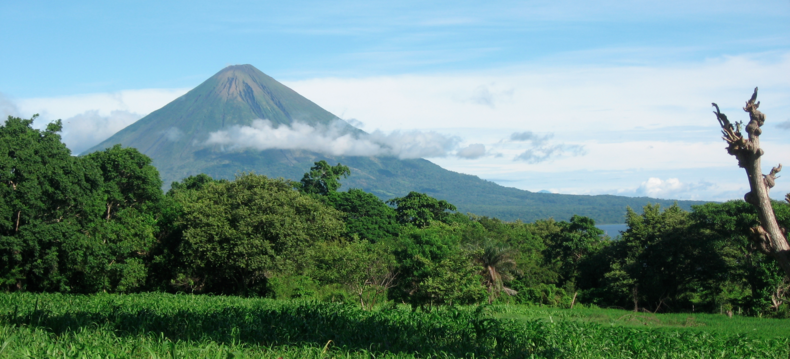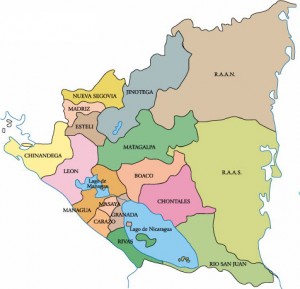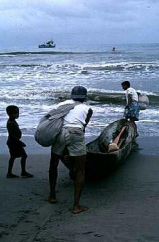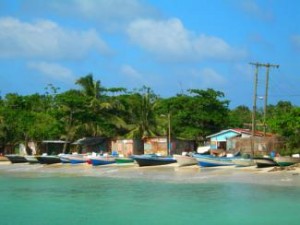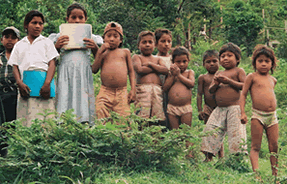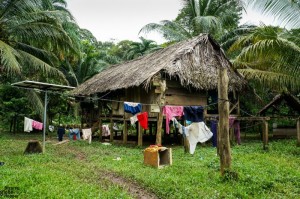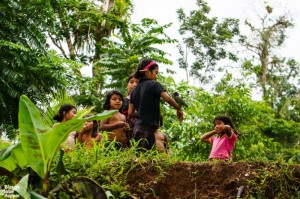Introduction:
In 2005, according to the VIII Censo de Población en Nicaragua, 8.6% of Nicaragua’s population identified as Indigenous. According to the CIA, 5% identified as Indigenous in 2007.[1] Today, while numbers have surely dwindled, the indigenous Nicaraguan community makes up a significant part of Nicaragua’s culture and heritage. The indigenous groups today are centered in the North Atlantic Region (RAAN) and South Atlantic Region (RAAS), but are also found in the Pacific, Center, and North of Nicaragua.
The RAAN and the RAAS are on the right side in brown and green.
History[2]
The history behind the indigenous groups of Nicaragua adds a lot of context to their realities today. The Pacific and Atlantic sides of Nicaragua were colonized at the same time. The Spanish brutally took over the Central and Pacific coast, wiping out a lot of the indigenous populations there. The indigenous groups were attacked; many were enslaved and sent back to Spain, and the rest were mixed with Spanish colonizers. The result over time was a group of Spanish-speaking, Catholic peoples with remaining mestizo culture. Today, few Mayagna communities remain on the Pacific Coast. [3]
The Atlantic Coast people were not attacked by the Spanish, and did not interact that much with the European colonizers. The groups there were the Mayagna and the Rama. However, in the 17th century the British began to use the hardwood trees as hideouts in the region associated with the Miskitu people. Along with those of African descent in the Caribbean that began migrating to the Atlantic coast, Europeans also began to mix with people of that region, evolving a distinct Miskitu culture. The Miskitu developed a strong trading relationship with the British, gaining access to firearms and other imports.
In the late 17th century, British traders and settlers brought Africans to the Nicaraguan Atlantic Coast for forced labor timber extraction and plantation work.[4] In the late 19th century, people from Jamaica and Belize migrated to the Atlantic coast for economic reasons. The distinct English-speaking minority became known as the Creoles, and the group’s population extended down the southern Atlantic Coast.
In 1860, the Atlantic Coast claimed the region from the British, and the people ruled autonomously for decades. In the 1890s, the United States began to take interest in the natural resources of the Atlantic Coast, and began establishing enterprises for fruit, gold, and timber extraction. The region lost its autonomy in 1994, when the Nicaraguan national army invaded the Caribbean coast with the aid of US marines and forced territorial integration under central government control. The Mestizo migrated to the coast as a result, and there was pressure for the assimilation of the Caribbean Coast into the dominant Pacific based mestizo groups.
A war of liberation against American occupation broke out on the Atlantic Coast, Miskitu areas. Under the incoming dynasty of the Somoza dictatorship, the Caribbean Coast continued to be sidelined and taken advantage of. Somoza García retained the United States as Nicaragua’s ally, and gave US companies the freedom to exploit Nicaragua’s gold, silver, timber, and seafoods.
The Mestizo migration to the coast continued to increase during the Somoza era, which heightened Caribbean Coast anger and dislike towards to Pacific region. After the assassination of Somoza García, his son Anastasio Somoza Debayle took over command of the national guard.
During Anastasio Somoza’s reign, leader Augusto Sandino formed the revolutionary group the Sandinista National Liberation Front (FSLN). The group was inspired by the Cuban revolution, and during the 1960s, the FSLN gained support among the unhappy Nicaraguan population, which included the students, rural Nicaraguans, and poor urban youth of the Pacific. Fighting went on for many years between the FSLN and the National Guard, and the Sandinistas began to gain steam right after the 1972 Managua earthquake.
In 1978, the Sandinista force seized the National Palace, taking the Nicarguan congress hostage. They officially took over power on July 19th, 1979, after the death of about 50,000 Nicaraguans in the revolutionary effort. Relations with the United States decreased as anticommunist Reagan did not support the direction in which Nicaragua was going. The Sandinistas increased their efforts to have Nicaragua under a more socialist economic structure, and the anger of the Pacific regions towards the Caribbean Coast continued to brew.
The relationship between the socialist Sandinistas and Coastal indigenous and Creole communities worsened over time. After the Sandinista victory and 1984 elections, the Autonomy Law was established in 1987. The aim of the Autonomy Law was to increase attention towards the rights of the coastal people’s, and the indigenous groups welcomed the law as an opportunity for multi-ethnic cultural, linguistic, religious, historic trade rights and to share the exploitation of their natural resources. Although the law was adopted, the reality of regional autonomy has not made as much headway as it should have. Despite the autonomy, the increasing influence of Managua-based national political parties continue to compromise the original intention of the autonomy.
People
Main Indigenous groups: Miskitu, Mayangna, Rama
Miskito (Miskitu)
The Miskito people live in the region that expands down the Mosquito Coast from Cape Camaron, Honduras, to Rio Grande. They are historically a mix of hunter-gatherers, fishermen and gardeners. Today they are known for their maritime roots, and are very involved in the lobster trade. The population is about 200,000 people, 180,000 of which speak Miskitu, their Misumulpan local language. Second languages are Spanish and Creole English.[5] There are three variants of Miskito in Nicaragua: the Wangki who live in the Coco River area, the Táwira, who live in the North plains, South plains, and Northern and Southern coasts of the RAAN, and the Baldams, who live in the Pearl Lagoon basin and the mouth of the Río Grande of Matagalpa in the RAAS.[6] Today, a considerable population of Miskito has migrated to Corn Island and Bluefields.
Men going out to collect Lobsters.
Corn Island.
Miskito history is marked by the intrusion of foreign peoples in Nicargua. The first contact that the Miskito had to foreigners occurred when Northern Europeans crashed their ships of the coast, and African ex-slaves swam to shore and mixed with the Miskitos. They formed people known as “Miskitos Zambos.”[7] Later on, the British fostered a connection with the Miskitos, claiming the Miskito kingdom as a British Protectorate. The British protected the Miskitos from the Spaniards and created an informal trade agreement. The Miskitos lived in unspoken autonomy until 1894, when the Nicaraguan state absorbed them into its rule. The Miskito at this time were greatly influenced by central Nicaragua and their British partners, and many adopted Christianity and European clothing.[8]
Today, the Miskito have become commercially focused for work, with great involvement in the lobster export industry and other forms of labor. Men have begun to join migrant labor forces, while women remain economic and authoritative masters of the house. Recently, the Miskito have suffered from state intervention and unfair land expropriation. Many Miskitos joined the contras in guerilla bands in the 1980s, fighting against the Sandinista Junta, which allegedly sought to disempower the Miskito.[9] The fighting resulted in Miskito massacres, and incited many Miskito to flee to Honduras.
In 2009, the Miskito announced the independence from Nicaragua as “The Community of Nation of Moskitia,” but there has been no global or Nicaraguan response to the declaration.[10]
Mayangna (Sumu)
The Mayangna people live on the eastern Misquito coast of Nicaragua, and speak their own Misumalpan language variant, known as Mayagna. According to a 2011 survey by the Mayanga government, the population is approximately 18,000 people. They inhabited much of the coast in the 16th century, but, since then, continue to be marginalized by the Miskito. Most speak Mayangna at home, but can also speak Miskito as they have a strong presence in their region.[11]
The Mayanga are concentrated in the RAAN and Jinotega, but many Mayanga communities are in or near the Bosawás Biosphere reserve, which is known recently for illegal timber extraction and unwarranted agricultural expansion.
In 2001, the Mayanga of a small community Awas Tingi, which has less than 1100 people, won an important ruling from the Inter-American Court of Human rights, which was established in 1979 by an agreement among the signatories of the Organization of the American States (OAS).[12] The ruling declared that indigenous people had rights to the land where they traditionally lived.
Awas Tingi
Rama
The Rama are known as the “Guardians of the Forrest.” There are nine distinct Rama communities (Rama Cay, Sumu Kaat, Tiktik Kaany, Wiring Cay, Monkey Point, Bangkukuk, Corn River, Indian River and Greytown), all of which inhabit the RAAS. About 50 families live in the area of Greytown and Rio Indio in the Indio Maíz, which can only be reached by 8 hours of travel in a small motor boat.
The tradition of the Rama remains strong. Many Rama still use the traditional canoe, carved out of a single log of a tree. Most Rama also still live in traditional houses, built from wood and other materials from the forest. They have adopted some modern technologies as well, with solar panels to produce some electricity for lights, radios, and TVs.[13] A major concern for the Rama is the loss of the Rama language. Today, only 1% of the Rama speak the language, which represents a deterioration of Rama tradition. Most Rama speak “Rama Cay Creole,” which is a strange mix of Creole English, Spanish, and Rama.
Governance
The 1987 Autonomy Law created the 2 autonomous zones of the RAAN and the RAAS. Nicaragua recognizes indigenous rights in its constitution today, stating that: “The State recognize the existence of indigenous communities that enjoy rights, duties and warranties established in the Constitution and specially maintain and develop their identity and culture, having their own forms of social organization and management of local matters. As well, preserve the communal forms of land properties and usage of the same ones, according to the law. For the communities of the Atlantic Coast (Caribbean) is established the autonomy regimen in the constitution.”[14] Coastal populations have taken many of their own initiatives, including the creation of the University of the Autonomous Regions of the Atlantic Coast (URACCAN) in 1995.
Here are some statistics of hardships that the people of the RAAN and RAAS are facing:
- Between 2003 and 2008, extreme poverty rates dropped by as much as 14% in most of the country, but increased by 11.1% among indigenous and minority populations of the Caribbean coast.
- Unemployment in the autonomous regions is estimated to be as high as 90%, while the country as a whole has a rate of about 7%.
- Illiteracy rates in the autonomous regions are 43%, compared to 23% for the entire country.
- There are over 5,000 primary schools in Nicaragua, but only 200 are located in autonomous regions.
- 2% and 24% of people in the RAAN and RAAS respectively are provided with drinking water, compared to 60-70% in the Pacific regions.
[1]** Statistics form Shannon Carman’s Dartmouth WordPress site: https://journeys.dartmouth.edu/lacs20carman/indigenous-peoples-of-nicaragua/
http://www.yorku.ca/cerlac/URACCAN/Mapa02.jpg
http://www.changeforchildren.org/international/projpartners/nicaragua.html
http://jpe.library.arizona.edu/volume_5/4dodd.pdf
http://www.more.com/sites/default/files/imagecache/slideshow_thickbox/littlecorn.jpg
https://vianica.com/go/specials/32-current-indigenous-communities-of-nicaragua.html
[1] http://www.refworld.org/docid/4954ce1bc.html
[2] http://www.refworld.org/docid/4954ce1bc.html
[3] http://www.refworld.org/docid/4954ce1bc.html
[4] http://www.refworld.org/docid/4954ce1bc.html
[5] https://intercontinentalcry.org/indigenous-peoples/miskito/
[6] https://vianica.com/go/specials/32-current-indigenous-communities-of-nicaragua.html
[7] https://intercontinentalcry.org/indigenous-peoples/miskito/
[8] https://intercontinentalcry.org/indigenous-peoples/miskito/
[9] https://intercontinentalcry.org/indigenous-peoples/miskito/
[10] https://intercontinentalcry.org/indigenous-peoples/miskito/
[11] https://intercontinentalcry.org/indigenous-peoples/mayagna/
[12] https://intercontinentalcry.org/indigenous-peoples/mayagna/
[13] http://www.bizarreglobehopper.com/blog/2015/01/13/indigenous-people-of-nicaragua-the-rama/
[14] https://vianica.com/go/specials/32-current-indigenous-communities-of-nicaragua.html
[1] https://journeys.dartmouth.edu/lacs20carman/indigenous-peoples-of-nicaragua/
